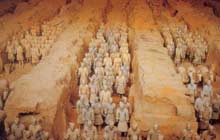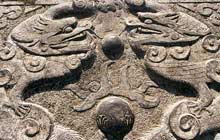
Day One
Depending on what time you arrrive in Xi'an, you might want to take a stroll around the city to get yourself acquainted with this bustling metropolis. Most impressive are the well-preserved city wall and the Bell Tower, the latter being the central-most point of Xi'an. Just south of the Bell Tower is Shuyuanmen, a traditional street full of antique and craft shops. This evening you will be treated to a private dumpling and noodle-making lesson. ( Xi'an Sofitel) (D)
 day two
day two
Competing Chinese kingdoms were united for the first time within a single empire by the virile King Zheng, of the Kingdom of Qin. Renamed as Emperor Qin Shihuangdi, this bellicose tyrant was the first to unite the various kingdoms of ancient China, though he is better known to us for his Terracotta Warriors. This morning you can view the the thousands of molded soldiers, officers, horses and wagons, which form part of this famed underground army.
China’s capital during the Han (206BC-220AD) and Tang (618-907AD) dynasties, periods of increasing international exposure, Xi’an became home to motley communities of Nestorian Christians, Zoroastrians, Buddhists, Jews & Muslims – many of whom have left their mark. This afternoon, for example, you will tour the Beilin Museum, a former Confucian Temple which houses an eighth century Christian stone tablet amongst its collection of Chinese Classics. Following this, we will observe the enduring influence of Xi’an’s Muslim community in its Great Mosque and forever-bustling Muslim Quarter. (B, L, D)

day three
As the capital of twelve dynasties spanning over 1,100 years, Xi’an will certainly not disappoint art enthusiasts. For example, where else would you expect to find wonderful Tang dynasty ceramic horses but in its former capital? Xi'an's well-presented History Museum will help you trace the development of Chinese culture from the third millenium BC to the demise of the Tang dynasty in the tenth century.
Time allowing, you may wish to visit the stunning Yangling Museum, dedicated to the tomb of the Western Han dynasty emperor, Liu Qiu (188 – 141 BCE). The artifacts unearthed here, while similar in purpose to those found in the more famous tomb of Emperor Qin, are far more varied. For example they include courtesans, buildings and farm animals as well as soldiers. Highly stylized, they are also elegant – this is one of the most sophisticated displays you will find anywhere in China. (B, L)
Please note that B, L, D denotes Breakfast, Lunch Dinner.
The above Xi'an tour itinerary is arranged on a private basis only. Visitors interested in a group tour of China, should view our frequentImperial Tour itinerary.